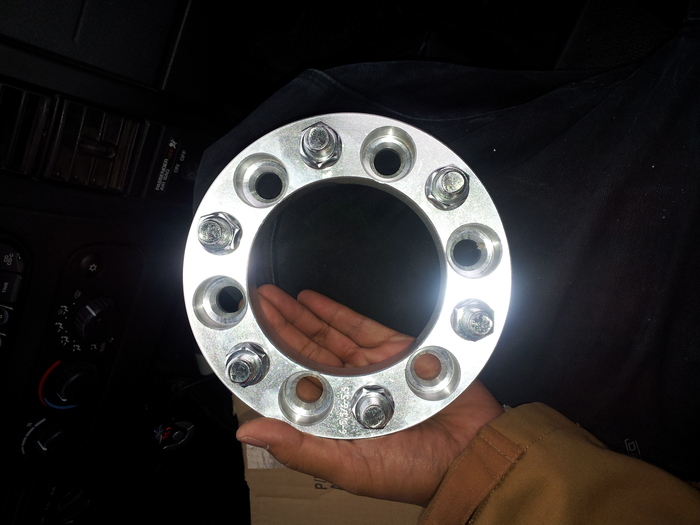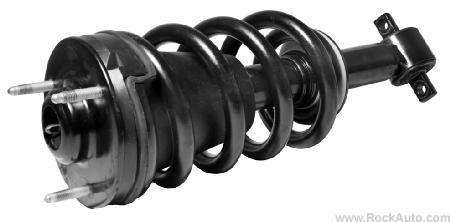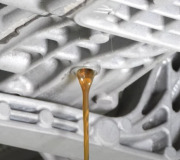Friday, September 21st, 2012 AT 8:44 PM
How to install these spacers I bought for the rear of the vehicle to raise it up 1.25"
4 Replies
Are you 100% sure? Here are 2 links that is comparible to my lift spacers.
http://www.sdtrucksprings.com/index.php?main_page=product_info&products_id=6986
http://www.strutmasters.com/ReadyLift-Suspension-s/625.htm
What do you think?
http://www.sdtrucksprings.com/index.php?main_page=product_info&products_id=6986
http://www.strutmasters.com/ReadyLift-Suspension-s/625.htm
What do you think?
Was this helpful?
Yes
No
Friday, September 21st, 2012 AT 9:34 PM
I guess you're right. I've been a suspension and alignment specialist since the mid '80s and I've never seen such a product. They look exactly like adapters I've used on off-road vehicles to put different wheels on the car but I'd never use them for customers' cars.
To install these spacers you have to remove the front struts. That can be a do-it-yourself procedure since you're not actually disassembling the spring from the strut. That requires raising the truck and supporting it on jack stands under the frame, not under the lower control arms. The control arms will have to be pried down once the strut is unbolted and you can't do that if the weight of the truck is on them. Don't touch the larger center nut. I included a photo of the assembly from Rock Auto. You can see the three silver bolts on top. Find three holes in the spacer that match those three bolts, then put three new bolts in corresponding holes in the spacer, and mount the spacer to the top of the strut assembly. Reinstall the strut that way.
1 1/2" isn't much but be aware that you'll be changing the relationship between the spindles / wheels and the frame. That means the geometry of the steering linkage is going to change as well as some secondary alignment angles. In any case you will want to have the truck aligned when you're done. Unlike 95 percent of lightweight cars with struts, on your truck they do not get involved with adjusting "camber", one of the three primary alignment angles, but camber will still change significantly from changing the ride height. The upper and lower control arms are always different lengths to cause the wheel to tip in and out on top as the body goes up and down along the road. That reduces the amount of sideways scrubbing on the tires, and reduces tire wear. By raising the ride height the two control arms will drop down and arc inward different amounts. Again, 1 1/2" isn't a lot but it will make a big difference on the alignment computer. As proof, once your truck is aligned, ask the mechanic to pull down on the front bumper an inch and watch the numbers change on the computer. "Camber" is the inward and outward tilt of the top of the wheel as viewed from in front of the truck. That has to be set correctly to minimize edge wear on the front tires. One of the concerns we always have on older vehicles with weak springs is that although we can set the alignment for perfect numbers on the hoist, that doesn't take into account the changes in geometry the suspension parts go through on the road. You will still have miserable tire wear if ride height isn't right.
As an alignment specialist I am dead set against any modifications to ride height, both from a tire wear and handling aspect and from a lawsuit concern, but if someone was determined to raise the height, these spacers look like probably the best way to do it. When people put 4" to 6" lift kits in or when they lower their cars, I don't want to be involved, even to just set the alignment. Even with all of my old muscle cars with easily adjustable torsion bars, I make sure each one is set exactly to specs.
To install these spacers you have to remove the front struts. That can be a do-it-yourself procedure since you're not actually disassembling the spring from the strut. That requires raising the truck and supporting it on jack stands under the frame, not under the lower control arms. The control arms will have to be pried down once the strut is unbolted and you can't do that if the weight of the truck is on them. Don't touch the larger center nut. I included a photo of the assembly from Rock Auto. You can see the three silver bolts on top. Find three holes in the spacer that match those three bolts, then put three new bolts in corresponding holes in the spacer, and mount the spacer to the top of the strut assembly. Reinstall the strut that way.
1 1/2" isn't much but be aware that you'll be changing the relationship between the spindles / wheels and the frame. That means the geometry of the steering linkage is going to change as well as some secondary alignment angles. In any case you will want to have the truck aligned when you're done. Unlike 95 percent of lightweight cars with struts, on your truck they do not get involved with adjusting "camber", one of the three primary alignment angles, but camber will still change significantly from changing the ride height. The upper and lower control arms are always different lengths to cause the wheel to tip in and out on top as the body goes up and down along the road. That reduces the amount of sideways scrubbing on the tires, and reduces tire wear. By raising the ride height the two control arms will drop down and arc inward different amounts. Again, 1 1/2" isn't a lot but it will make a big difference on the alignment computer. As proof, once your truck is aligned, ask the mechanic to pull down on the front bumper an inch and watch the numbers change on the computer. "Camber" is the inward and outward tilt of the top of the wheel as viewed from in front of the truck. That has to be set correctly to minimize edge wear on the front tires. One of the concerns we always have on older vehicles with weak springs is that although we can set the alignment for perfect numbers on the hoist, that doesn't take into account the changes in geometry the suspension parts go through on the road. You will still have miserable tire wear if ride height isn't right.
As an alignment specialist I am dead set against any modifications to ride height, both from a tire wear and handling aspect and from a lawsuit concern, but if someone was determined to raise the height, these spacers look like probably the best way to do it. When people put 4" to 6" lift kits in or when they lower their cars, I don't want to be involved, even to just set the alignment. Even with all of my old muscle cars with easily adjustable torsion bars, I make sure each one is set exactly to specs.
Was this helpful?
Yes
No
Friday, September 21st, 2012 AT 10:21 PM




